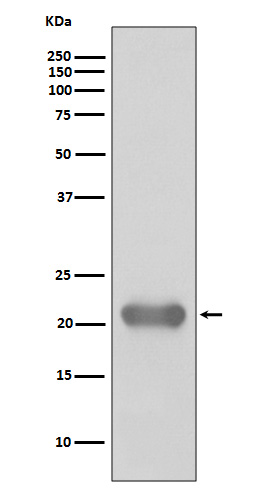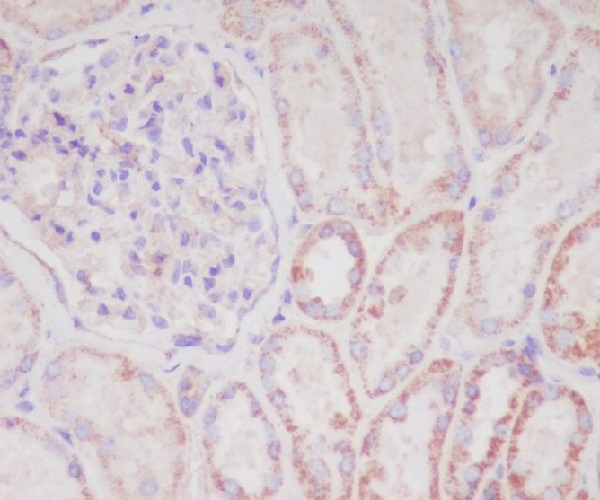Anti-Smac/Diablo Rabbit Monoclonal Antibody
- SPECIFICATION
- CITATIONS
- PROTOCOLS
- BACKGROUND

Application
| WB, IHC, IF, ICC, IP, FC |
|---|---|
| Primary Accession | Q9NR28 |
| Host | Rabbit |
| Isotype | Rabbit IgG |
| Reactivity | Rat, Human, Mouse |
| Clonality | Monoclonal |
| Format | Liquid |
| Description | Anti-Smac/Diablo Rabbit Monoclonal Antibody . Tested in WB, IHC, ICC/IF, IP, Flow Cytometry applications. This antibody reacts with Human, Mouse, Rat. |
| Gene ID | 56616 |
|---|---|
| Other Names | Diablo IAP-binding mitochondrial protein {ECO:0000312|HGNC:HGNC:21528}, Diablo homolog, mitochondrial {ECO:0000312|HGNC:HGNC:21528}, Direct IAP-binding protein with low pI {ECO:0000312|HGNC:HGNC:21528}, Second mitochondria-derived activator of caspase, Smac, Diablo IAP-binding mitochondrial protein, cleaved form, DIABLO (HGNC:21528) |
| Calculated MW | 27131 MW KDa |
| Application Details | WB 1:1000-1:5000 IHC 1:50-1:200 ICC/IF 1:100-1:500 IP 1:50 FC 1:50 |
| Subcellular Localization | Mitochondrion. Released into the cytosol when cells undergo apoptosis. |
| Tissue Specificity | Ubiquitously expressed with highest expression in testis. Expression is also high in heart, liver, kidney, spleen, prostate and ovary. Low in brain, lung, thymus and peripheral blood leukocytes. Isoform 3 is ubiquitously expressed.. |
| Contents | Rabbit IgG in phosphate buffered saline, pH 7.4, 150mM NaCl, 0.02% sodium azide and 50% glycerol, 0.4-0.5mg/ml BSA. |
| Clone Names | Clone: FGG-4 |
| Immunogen | A synthesized peptide derived from human Smac/Diablo |
| Purification | Affinity-chromatography |
| Storage | Store at -20°C for one year. For short term storage and frequent use, store at 4°C for up to one month. Avoid repeated freeze-thaw cycles. |
| Name | DIABLO (HGNC:21528) |
|---|---|
| Function | Promotes apoptosis by activating caspases in the cytochrome c/Apaf-1/caspase-9 pathway. Acts by opposing the inhibitory activity of inhibitor of apoptosis proteins (IAP). Inhibits the activity of BIRC6/BRUCE by inhibiting its binding to caspases (PubMed:15200957, PubMed:36758104, PubMed:36758105, PubMed:36758106). |
| Cellular Location | Mitochondrion. Cytoplasm, cytosol Note=Released into the cytosol in a PARL-dependent manner when cells undergo apoptosis. |
| Tissue Location | Ubiquitously expressed with highest expression in testis. Expression is also high in heart, liver, kidney, spleen, prostate and ovary. Low in brain, lung, thymus and peripheral blood leukocytes. Isoform 3 is ubiquitously expressed |

Thousands of laboratories across the world have published research that depended on the performance of antibodies from Abcepta to advance their research. Check out links to articles that cite our products in major peer-reviewed journals, organized by research category.
info@abcepta.com, and receive a free "I Love Antibodies" mug.
Provided below are standard protocols that you may find useful for product applications.
If you have used an Abcepta product and would like to share how it has performed, please click on the "Submit Review" button and provide the requested information. Our staff will examine and post your review and contact you if needed.
If you have any additional inquiries please email technical services at tech@abcepta.com.













 Foundational characteristics of cancer include proliferation, angiogenesis, migration, evasion of apoptosis, and cellular immortality. Find key markers for these cellular processes and antibodies to detect them.
Foundational characteristics of cancer include proliferation, angiogenesis, migration, evasion of apoptosis, and cellular immortality. Find key markers for these cellular processes and antibodies to detect them. The SUMOplot™ Analysis Program predicts and scores sumoylation sites in your protein. SUMOylation is a post-translational modification involved in various cellular processes, such as nuclear-cytosolic transport, transcriptional regulation, apoptosis, protein stability, response to stress, and progression through the cell cycle.
The SUMOplot™ Analysis Program predicts and scores sumoylation sites in your protein. SUMOylation is a post-translational modification involved in various cellular processes, such as nuclear-cytosolic transport, transcriptional regulation, apoptosis, protein stability, response to stress, and progression through the cell cycle. The Autophagy Receptor Motif Plotter predicts and scores autophagy receptor binding sites in your protein. Identifying proteins connected to this pathway is critical to understanding the role of autophagy in physiological as well as pathological processes such as development, differentiation, neurodegenerative diseases, stress, infection, and cancer.
The Autophagy Receptor Motif Plotter predicts and scores autophagy receptor binding sites in your protein. Identifying proteins connected to this pathway is critical to understanding the role of autophagy in physiological as well as pathological processes such as development, differentiation, neurodegenerative diseases, stress, infection, and cancer.



